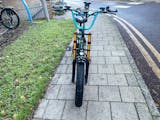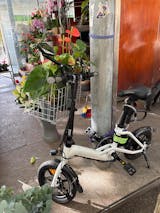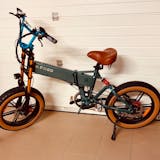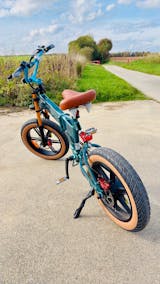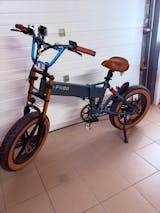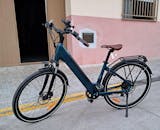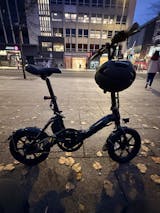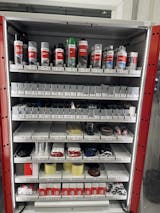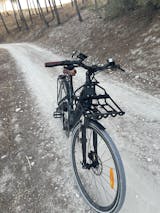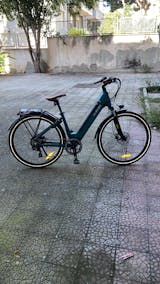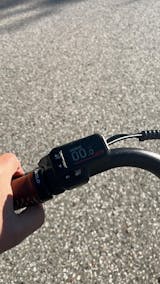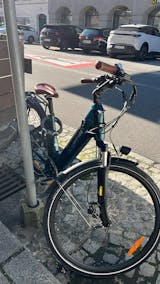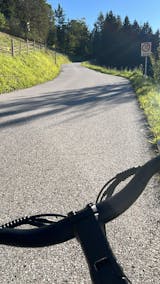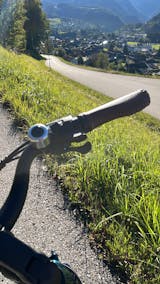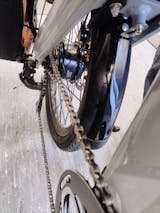Affordable, a well designed and a light weight e bike good for daily used, suitable for everyone.
I would like to thank you to the delivery company for the delivery on time. It is a beautiful, very well finished bicycle. I had a short ride due to the weather condition and I am very impressed. I did not tested the autonomy but I expect to be similar to the hibrid cars, the more support used les autonomy received but is all assumed. I am very happy with my new C11 Pro. I am planning of buying a Nomads model as well, soon. Thank you Fiido for the quality and price.
Wow where do I start! I Bought The M1 Pro 2025 edition to replace my 5 year old very trusted D4S, And wow I was not disappointed, the M1 Pro 2025 is amazing, the power difference between the bikes is incredible, I was a bit overwhelmed by its size at the start when I built it but after a few days i never looked back, the bike meets all my needs, 100% UK legal and just so much fun to ride and the quality is outstanding. Not only do fiido create outstanding bikes but their customer service is also outstanding. Fiido have a customer for life with me..
Πρώτη φορά έρχομαι σε επαφή με ένα ηλεκτρικό ποδήλατο και από τη πρώτη στιγμή μου κέρδισε τις εντυπώσεις! Το χρησιμοποιώ στην καθημερινότητά μου και όχι μόνο! Χθες για την ακρίβεια το ποδήλατο δοκιμάστηκε σε μια διαδρομή 60 χιλιομέτρων και πήγε εξισου καλά και στο δρόμο αλλά και στην off road διαδρομή! Όσον αφορά τη μπαταρία του ( ξεχνάς να το φορτίσεις) 5 αστέρια σίγουρα!
Estoy n cantada con mi bici, me hace tan feliz pesar que tengo que ir aquí y allí y que iré con ella!! Todo el mundo me pregunta y se paran a mírala 🥰❤️💃🏼💃🏼💃🏼
Muy visible desde lejos. Lo mejor es que cuando frenas la luz se potencia para que sepan que estás frenando y es un punto a favor. Tener en cuenta que va colocada en la parrilla por lo que si no la tenéis no podréis colocarla. Muy recomendable.
M1 Pro envoyé rapidement et conforme aux descriptions du site.
Qualité et service au rendez-vous.
Service après vente réactif
Super fiets, maakt fietsen weer leuk, zeker als je al wat ouder bent. Jeugdsentiment omdat ik vroeger een bmx crossfiets had. Ik vond het stuur alleen niet zo passen bij de rest van de fiets dus heb deze mat zwart gespoten voordat ik 1 meter gefietst had zodat hij beter bij de rest van de fiets paste. Heb alleen maar positieve reacties gekregen.
Im Bereich großer E-Bikes mit 28 Zoll Rädern gibt es zur Zeit in diesem Preissegment nichts besseres !

Tengo puesta la cesta en la bicicleta C11 pro. Es muy útil para las compras con unos pulpos para asegurar la mercancía. Es robusta y parece duradera.
Od pierwszego wejścia na rower D3 Pro jestem wprost zachwycony wygodą i stabilnością tego małego roweru. Wspaniale zaprojektowany i precyzyjnie wykonany rower, który idealnie spełnia swoje zadanie. Dojazd do pracy i niedalekie wycieczki są teraz przyjemnością. Bardzo wydajny akumulator i silnik. Spokojnie można z niego skorzystać również na dłuższych trasach. Składanie roweru jest bardzo przemyślane i łatwe. Można to zrobić naprawdę szybko. Rower bez problemu przewoziłem już w aucie jak i pociągu. Jest naprawdę bardzo mobilny. Miałem małego pecha z przewoźnikiem, karton w transporcie został nieco uszkodzony. Zrobiłem zdjęcia, skontaktowałem się z obsługą klienta i opisałem sytuację. Reakcja była bardzo konkretna i szybka. Po dwóch tygodniach otrzymałem przesyłkę z nowym siodełkiem i błotnikiem. Jako klient, poczułem się naprawdę rzetelnie i dobrze obsłużony. Dlatego gorąco polecam sam produkt Fiido jak również sprawnie działającą obsługę klienta i serwis.
It’s a versatile and well-built machine that can substitute your car for school run, running errands and other day-to-day bits. Motor is powerful, brakes are amazing. However, it has same downsides of course. Some are serious, some are manageable.
Serious ones:
-Positioning of the light: this is a certain design flaw. Anyone who uses this bike will get it immediately. Solution: Mount the light onto the front fender.
-If you’re taller than 180cm, be aware of uncomfortable knees during long rides. It’s not easy to pedal for tall people, and the max seat height is not enough to manage it.
Somehow manageable
-Uncompatible tail space: Universal accessories can be bought from Decathlon are not easily mounted on this bike. Frame has a different geometry than the usual bikes in Europe (Diameter of frame bars are bigger than those). So, think twice if you’re into getting accessories from common retailers around the corner.
Dear rider,
Thank you very much for taking the time to share your feedback about your Fiido M1. We truly value your input and would like to provide you with clear explanations and assistance:
1. Display Memory Issue
After the display is powered off, certain data such as riding time and current trip distance will automatically reset. This is part of the normal system design. These values will start counting again when the bike is turned on.
If you are referring to other parameters (such as speed units or assist levels) being reset, please let us know so that we can investigate further.
2. Automatic Unit Switching (km/h → mph)
The display does not automatically switch between kilometers and miles per hour. In most cases, this happens when the buttons are double-tapped or accidentally pressed.
In future firmware updates, this function will only be adjustable through the Fiido App, preventing accidental changes from the display buttons.
3. Trip Distance Resetting
Similar to the first point, the current trip distance will automatically reset after the display is powered off — this is normal behavior. The total distance (ODO), however, will remain saved.
4. Bluetooth and Internet Connection
The Fiido App already supports offline Bluetooth operation, so an internet connection is not required. Please make sure your phone’s Bluetooth is turned on and is within close range of the bike.
5. Unable to Open the Settings Page
Please ensure that the bike is successfully connected via Bluetooth before entering the “Settings” page. This page can only be accessed when a Bluetooth connection has been properly established.
We hope the above information helps clarify the situation. If the issue persists, please contact our support team at support@fiido.com
, and we will assist you as soon as possible.
Thank you for your understanding and continued support!
Warm regards,
Fiido Team
Ich habe mein Rad seit April 2025 bin totall zufrieden mit und würde es wieder kaufen..
Tolles Rad
Recibimos correctamente la bicicleta perfectamente empaquetada. satisfechos de la bici cumple todas las expectativas.
Veramente bella e non passa nemmeno inosservata, funzionale per la città, tecnologica e leggera. La ricomprerei subito.
Bin sehr happy mit meinem Bike!
Am geraden fahren undauch bei mäßigen Steigungen top! Wenn es steiler wird, wir es sehr sportlich 😅! Dafür ist es nicht so geeignet! Aber wirklich ein top Gerät mit hervorragender Qualität!
Just recently got the Nomads and I have to say its quite an head turner. Looks fantastic, great finish and just a fun bike to ride

Das Fahrradkonzept insgesamt ist sehr gut, es fährt super und die 20 Zoll Reifen sind für normaler Untergründe ein guter Kompromiss zwischen Größe und Komfort. Nur auf Kopfsteinpflaster oder sehr huckeligen wegen wären große Reifen oder eine Federung notwendig. Der Antrieb ist sehr leise und in den kleineren Unterstützungsmodi kaum hörbar. Die Akkukapazität ist gut und entspricht bei normaler Benutzung mit kleiner bzw. mittlerer Unterstützung auch den Angaben. Bei größerer Unterstützung oder mit Anhänger wird die Reichweite natürlich kleiner, für meine Alltagsstrecken aber völlig ausreichend. Den Anhänger zieht das D11 auch problemlos Rampen hoch und dank E Unterstützung ist das Fahren mit Anhänger sehr leicht und macht Spaß.
Verpackung war super, alles kam in gutem Zustand an, Versand ging recht schnell und innerhalb einer Woche war das Fahrrad schon da. Montage super einfach und ging sehr schnell, max 20min., mitgeliefertes Werkzeug ist auch vollständig sodass man nicht mal selbst irgendwas zusammen kramen muss.
Schaltung musste ich noch minimal einstellen. Außerdem nach einigen gefahrenen Kilometern die Speichen nach spannen, da waren einige etwas locker, das ist bei neuen Fahrrädern aber völlig normal, weil diese sich erst unter Belastung setzen.
Schutzbleche und Lichtanlage sind auch gut und funktionieren super. Die verwendeten Komponenten machen einen hochwertigen Eindruck, Schaltung bisher top, hydraulische Bremsen super leicht zu bedienen und Bremskraft spitze gerade mit Anhänger war mir das wichtig.
Ich habe auch den Gepäckträger von fiido bestellt. Leider kam dieser erheblich später erst nach ca einem Monat und musste natürlich separat montiert werden. Hier hat mir eine kurze Anleitung mit ein paar Skizzen gefehlt, aber ich glaube es gibt dazu ein YouTube Video. Der Gepäckträger hat ebenfalls eine sehr gute Qualität und ist super stabil und trotzdem recht leicht. Leider quetschen die vorderen Befestigungspunkte das Schutzblech minimal. Außerdem kommen die mittleren Tragestangen etwas nach außen raus. Dies erschwert die Befestigung von gängigen Fahrradtaschen die am Rohr eingehängt werden, z.B. Ortlieb Taschen. Mit leichter Biegung geht es aber trotzdem. Leider ist kein Reflektor dabei, man kann das mitgelieferte Rücklicht/ Reflektor wahrscheinlich anstelle am Sattel am Gepäckträger anbauen, ich hatte noch einen Reflektor da. Hätte mir einfach gewünscht, dass schon ein Reflektor montiert gewesen wäre.
Die Sinnhaftigkeit der App hat sich mir noch nicht erschlossen, da im Sattelrohr am Akku ja ein mechanischer Schalter verbaut ist der auch das Rücklicht abschaltet, sodass man diesen sowieso manuell bedienen muss zusätzlich zum Schalter am Bedienteil am Lenker. Find my device funktioniert bei nicht richtig, weiß aber nicht genau ob das an meinem Telefon oder am Rad liegt. Ich kann es sehen wenn ich direkt am Fahrrad stehe aber sonst nicht weil man die App ja gar nicht öffnen kann wenn das Fahrrad nicht verbunden ist.
Bedienteil und Bedienung ist sehr schlicht und dadurch einfach und intuitiv. Die elektrische Hupe verbaut ist praktisch, allerdings identifizieren Menschen im Straßenverkehr damit kein Fahrrad, hier wäre eine Klingel Geräusch besser. Vielleicht könnte man das ja über die App zukünftig konfigurieren? Ein Modus für Unterstützung beim Schieben wäre noch hilfreich. Oder hab ich den nur nicht gefunden?
Sto usando la C21 per andare a lavoro, perfetta, ho fatto finora 250 km la batteria riesce a coprire i 25km di andata e ritorno. Unico upgrade che probabilmente farò sarà un supporto sella con molla, le buche si sentono veramente tanto. Per il resto oggetto ottimo, vediamo nel tempo come si comporta, per adesso voto 10.





















